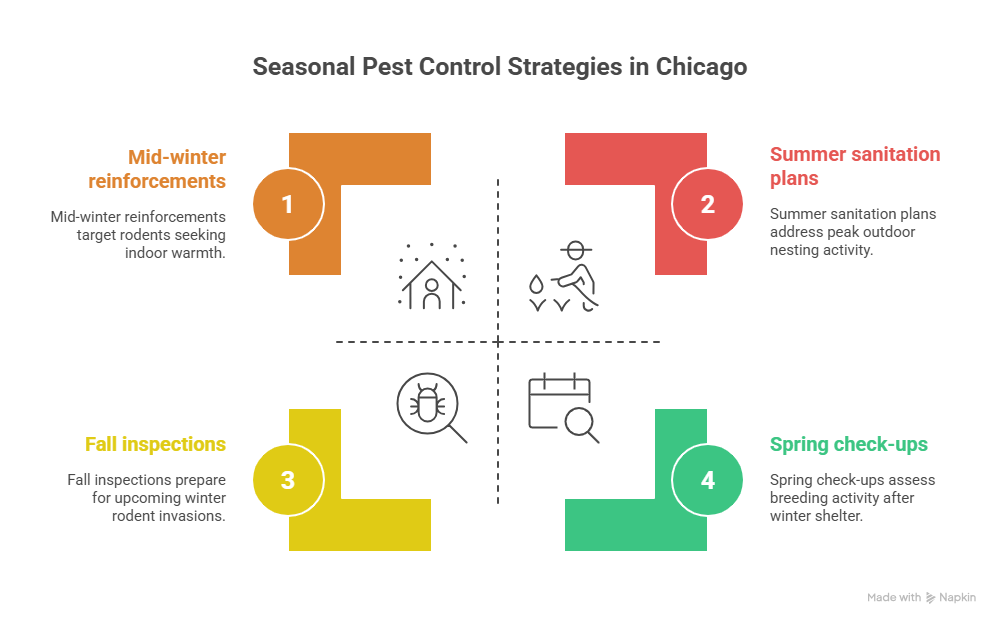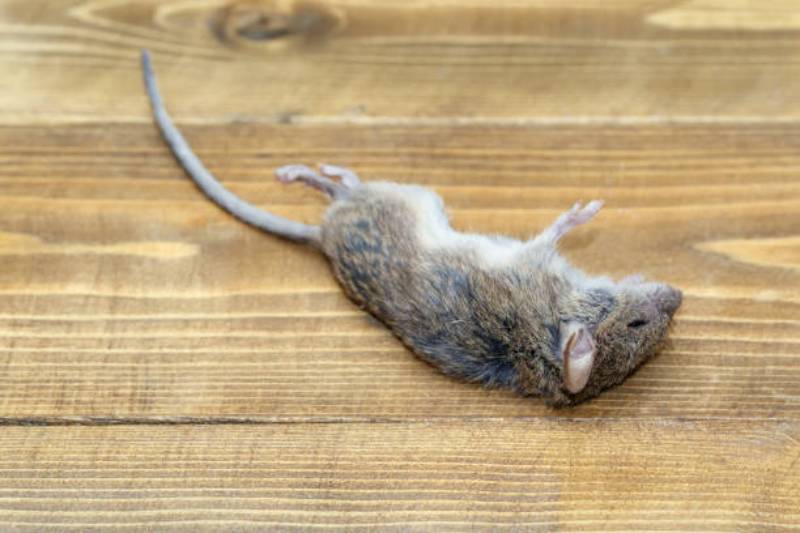In a city as vibrant and historic as Chicago, rodent problems are more than a mere annoyance, they’re a constant challenge. Between its aging infrastructure, dense neighborhoods, and extreme seasonal shifts, Chicago offers the perfect storm of conditions for rats and mice to thrive. And thrive they do. From alleyways and basements in Wicker Park to the attics of two-flats in Logan Square, rodents find countless ways to burrow into the lives of Chicagoans.
But today’s pest control pros aren’t playing by yesterday’s rules. Gone are the days of haphazard poison drops and reactive extermination calls. In their place? Innovation, science, and strategy.
Let’s dive into the groundbreaking methods pest control services, like the experts at Midwest Pest Solutions, are using to outsmart some of the city’s craftiest four-legged invaders.
Why Innovation Matters in Rodent Control
Traditional rodent control methods, think snap traps and generic poison baits, often fail to address the root causes of infestations. Not only that, they can leave behind a trail of health risks, unpleasant odors, and a growing resistance problem among rodents. Chicago’s savvy pest control teams have learned that it’s not enough to kill a rat; you have to understand it.
With the rise of Integrated Pest Management (IPM), eco-conscious strategies, and smart tech, the industry is turning a corner. Pest professionals are now combining biology, behavioral science, urban planning, and cutting-edge tools to design truly effective rodent removal plans tailored to the Windy City.
Integrated Pest Management: The Smart Science Behind It All
One of the most forward-thinking approaches currently gaining traction is Integrated Pest Management (IPM). This isn’t just a buzzword, it’s a game-changer. IPM takes into account the entire ecosystem of an infestation: where the rodents live, how they get in, what attracts them, and how they reproduce.
Rather than flooding a space with toxic chemicals, IPM emphasizes:
- Inspection and monitoring: Understanding the full scope of the problem.
- Physical exclusion: Sealing up entry points using materials like steel wool, hardware cloth, and door sweeps.
- Habitat modification: Removing nesting sites, clutter, and food sources.
- Targeted trapping: Using smart traps placed with surgical precision.
- Selective rodenticide use: Only when absolutely necessary, and with products designed to minimize harm to non-target species.
Landmark Pest Management has been a vocal advocate for IPM, noting that this strategy not only improves outcomes but also minimizes harm to children, pets, and the environment. In a city like Chicago, where buildings are packed tightly and families often live close to one another, that makes a world of difference.
Customized Inspections: No Two Homes Are the Same
Chicago is a city of character, and that applies to its homes, too. From charming greystones and classic bungalows to modern condos, every building has its own unique vulnerabilities when it comes to rodent entry. That’s why cookie-cutter solutions just don’t cut it.
Local pest control experts, like those at Midwest Pest Solutions, begin every job with a thorough, on-site inspection. Technicians look for:
- Gaps in foundations and brickwork
- Unsealed utility lines
- Crumbling mortar
- Drainage and sewer vulnerabilities
- Evidence of gnawing, droppings, or nesting
What follows is a personalized treatment plan, which may include bait placement, trap strategies, exclusion repairs, and a timeline for follow-up. That level of customization helps ensure that no blind spots are left unaddressed, and no rat slips through the cracks (literally).
Smarter Traps for a Smarter City
You may think of rodent traps as old-school, wooden boards and a metal snap, but today’s pest control tech looks a whole lot smarter.
Modern services are using electronic and tamper-resistant traps designed to work quietly, efficiently, and humanely. These devices not only reduce the risk of harming non-target species (like pets), they also offer real-time monitoring. That means professionals can check trap activity remotely, without needing to enter a property repeatedly or disturb residents.
Additionally, sealed bait stations protect the bait from weather, kids, and curious pets. These stations are discreet and safe, designed to blend into the environment while maintaining effectiveness over time.
Aerex Pest Control has noted that these advanced trapping systems significantly increase removal rates, particularly in dense city areas where rodents may have multiple food sources competing with traditional baits.
Eco-Friendly Solutions: Goodbye to Chemical Overload
Today’s Chicago residents are more eco-conscious than ever, and pest control companies are meeting them where they are. Green pest control isn’t a gimmick; it’s a full-fledged movement.
Professionals now rely on:
- Low-impact rodenticides that break down more quickly and reduce secondary poisoning risks
- Organic deterrents, like peppermint oil or ultrasonic repellents, especially in family homes
- Mechanical exclusion techniques over chemical warfare
- Habitat disruption through sanitation and clutter reduction, which naturally discourages rodents from settling
And it’s not just about being green for green’s sake, it’s about sustainability. Killing a few rats today doesn’t matter if more return tomorrow. Environmentally sound solutions focus on long-term prevention, not just one-off extermination.
Season-Specific Strategies: Winter is Coming (and So Are the Rats)
If there’s one thing every Chicagoan knows, it’s this: winter means layers, salt trucks… and rodents trying to crash in for warmth.
Chicago pest control companies understand that rodent behavior changes dramatically with the seasons. As temperatures drop, rodents seek out shelter, warmth, and consistent food supplies, making homes and businesses prime targets.
So professionals time their services accordingly:
- Fall inspections to prepare for winter invasion
- Mid-winter reinforcements, especially in basements and attics
- Spring check-ups to assess for any breeding activity
- Summer sanitation plans when outdoor nesting ramps up
This seasonal approach means clients don’t just get one treatment, they get a full, year-round strategy customized to Chicago’s weather cycles and rodent migration habits.


Beyond the Trap: How Chicago is Leading the Rodent Control Renaissance
The Role of the City in Rodent Control Innovation
When it comes to fighting rodents on an urban scale, the City of Chicago isn’t playing catch-up, it’s setting the pace. Through its robust municipal infrastructure, the city operates one of the most proactive rat control programs in the United States.
Spearheaded by the Department of Streets and Sanitation, Chicago’s rodent control system includes:
- Deployment of dry ice to humanely eliminate rats in burrows
- Investigations tied to sanitation code violations
- Proactive inspections in high-risk areas based on 311 complaint patterns
- Public education campaigns about garbage storage and environmental maintenance
This comprehensive approach is rooted in the understanding that rodents thrive where there’s access to food, water, and shelter, all of which are prevalent in densely populated, aging urban environments.
Dry Ice: The Chill Weapon in Urban Rodent Control
One of Chicago’s most headline-grabbing innovations is its use of dry ice to eliminate rats in underground burrows. This technique has proven both effective and humane. After inserting dry ice pellets into the burrow, the carbon dioxide released during sublimation displaces oxygen, causing rodents to suffocate painlessly.
Dry ice usage was briefly halted years ago until the Environmental Protection Agency (EPA) reapproved it as a safe and restricted-use rodenticide. Chicago quickly reintegrated it into its city-wide control plan.
Because it leaves no toxic residue and avoids the side effects of traditional poisons (like rodents dying behind walls), dry ice has become a staple of the city’s modern, non-disruptive rodent control arsenal.
Rodent Birth Control? Yes, Really, and Chicago’s On Board
While traditional pest control often relies on extermination, Chicago has been exploring population control via fertility management. The pilot programs introduced by the city involve products like ContraPest, which interfere with rat reproduction.
This isn’t just speculative science. The concept is supported by findings from the National Institute of Food and Agriculture (NIFA), which backs fertility control as a scalable and humane solution for urban rodent populations.
Instead of killing rats, these baits reduce colony growth over time, allowing populations to taper off naturally. Chicago’s experimentation with this method positions it as a model city for innovative, long-term rodent reduction strategies.
Fighting Rats with Data: Predictive Analytics in Action
Chicago isn’t just deploying traps, it’s crunching numbers. Through its Smart Data Platform, the city uses analytics to predict rodent outbreaks based on factors like:
- 311 rodent complaint trends
- Weather fluctuations
- Garbage pickup schedules
- Structural risk factors tied to specific neighborhoods
The city maps rodent hotspots using GIS technology and then dispatches sanitation crews and inspectors accordingly. This data-informed approach enhances efficiency, allowing limited resources to be allocated where they’ll have the biggest impact.
The Office of Inspector General (OIG) reviewed this initiative in 2020 and offered several recommendations to improve transparency and interdepartmental collaboration, further refining what is already one of the most sophisticated urban pest forecasting systems in the country.
Public Health Integration: More Than Just Pest Control
Rodent infestations aren’t just a property management problem, they’re a public health issue. According to the Centers for Disease Control and Prevention (CDC), rats and mice are known carriers of more than 35 diseases, including leptospirosis, hantavirus, and salmonella.
That’s why Chicago has taken a multi-agency approach, integrating rodent control into the missions of:
- Public health departments
- Public schools
- Housing authorities
- Sanitation services
By linking efforts between agencies, the city ensures that pest control aligns with broader goals like community wellness, food safety, and affordable housing standards.
Chicago’s Infrastructure + Climate: A Rodent Haven
Chicago’s rodent woes are made worse by two stubborn realities: its aging infrastructure and its increasingly erratic climate.
According to the National Weather Service (NWS), warmer winters have expanded rat breeding seasons and allowed populations to stay active longer. Meanwhile, older housing stock, especially buildings with crumbling foundations, unsealed utility lines, or damaged sewers, creates endless entry points.
Federal housing audits back this up. The U.S. Department of Housing and Urban Development (HUD) frequently cites pest infestations as a critical deficiency in both public and private housing inspections, underscoring the link between poor infrastructure and increased rodent risk.
Wrapping Up This Section…
Chicago is doing more than reacting to rats, it’s leading the charge in rethinking how cities manage urban wildlife. From fertility control and predictive analytics to EPA-sanctioned dry ice and GIS mapping, these public-sector innovations serve as a model for cities across the country.
From Public Strategy to Private Solutions: Midwest Pest Solutions’ Tailored Approach
Bridging the Gap Between Citywide Programs and Your Front Door
While Chicago’s public pest control infrastructure sets the stage for cleaner neighborhoods, true peace of mind starts inside the home. This is where Midwest Pest Solutions comes in, translating municipal-scale innovation into targeted, property-specific action.
With older homes, multifamily buildings, and hybrid commercial spaces dotting the city’s landscape, rodent vulnerabilities are as varied as Chicago’s architecture. Midwest Pest Solutions specializes in adapting proven strategies, like exclusion sealing, smart traps, and seasonal prevention, to fit the unique challenges of each location.
Their process begins with a detailed on-site inspection and ends with a plan built around your needs, not a one-size-fits-all template.
Why DIY Rodent Control Usually Falls Short
Let’s be real: laying down a few glue traps and hoping for the best is a recipe for disappointment, and possibly disease.
Homeowners often underestimate:
- The complexity of entry points (including vents, crawl spaces, and utility lines)
- The intelligence and learning behavior of rats and mice
- The health risks of exposure to rodent urine, droppings, and dander
- The recurrence rate when sanitation and structural issues go unaddressed
Midwest Pest Solutions takes a holistic approach, using smart baiting techniques, pet-safe deterrents, and expert exclusion practices. Their techs are trained to spot what the untrained eye won’t, and act decisively before a small issue becomes a full-blown infestation.
Explore their Rodent Control Services to learn more about their treatment philosophy and service options.
Pet- and Child-Friendly Treatments: Safety First
One of the top concerns among homeowners is the safety of pest control treatments, especially with pets and children in the home. Midwest Pest Solutions addresses this head-on by offering:
- Tamper-proof bait stations to prevent accidental access
- Non-toxic deterrents where applicable (peppermint oil, ultrasonic devices, etc.)
- Exclusion sealing as a first line of defense, reducing reliance on chemicals
- Low-risk rodenticides applied only when needed and in safe zones
It’s part of a larger trend in pest control that prioritizes long-term safety over short-term aggression, echoing the same principles found in Chicago’s municipal programs.
The Follow-Up Factor: Why Ongoing Service Matters
Rodent control isn’t a one-and-done fix, it’s an ongoing battle. Midwest Pest Solutions offers scheduled follow-up visits, especially after initial treatment. These check-ins allow techs to:
- Assess new activity
- Replace or reset traps
- Re-seal any disturbed exclusion zones
- Reinforce sanitation best practices with property owners
For high-risk properties, seasonal packages are available to ensure rodents stay gone for good, especially during winter migration surges.
Why It All Matters: Rodent Control is Public Health
At the end of the day, rodent control is about more than property value or convenience. It’s a public health responsibility. Every successful treatment prevents disease transmission, reduces allergen exposure, and protects food sources.With both the City of Chicago and Midwest Pest Solutions tackling the problem from different angles, residents have a robust two-tiered defense system: one macro, one micro, and both critical.

